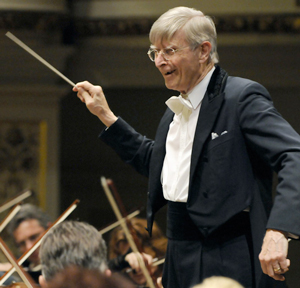by David Kulma

Mozart wrote his last three symphonies 230 years ago, in 1788. The last — No. 41 in C, K. 551 — has been justly celebrated for two centuries. Throughout this reading, Blomstedt gave the work a brisk smoothness. The phrases were long-breathed, and although the Orchestra always manages to fit in all the niceties of texture, timbre, and dynamics, this still meant that small nuances sailed by without much notice. There are times when this technique works — music director Franz Welser-Most is fond of this interpretative approach. But in the barrel-like acoustics of the Blossom Pavilion, a halo of muddiness washed over TCO’s fine precision.
The opening Allegro vivace maintained suaveness under the circumstances, while the third movement Menuetto lacked the necessary dancing quality as Blomstedt emphasized the silky, descending, chromatic lines. The famous finale, with its contrapuntal fugato and well-known head motive, blew by in a fury, the conductor emphasizing large-scale structure. What shone through in full glory was the liquid caramel Andante cantabile. The musical inevitability that Mozart achieved in his best works was clearly captured in TCO’s shimmering paragraphs of sound.
The Cleveland Orchestra came alive for Blomstedt in a magisterial rendition of Brahms’s Symphony No. 4 in e. Nearly a hundred years after Mozart’s last symphony was written, Brahms himself conducted the premiere of his own final symphony in 1885. Like his three previous entries in the genre, Brahms’ Fourth stays close to earlier symphonic practice, remaining within Beethoven’s orchestral instrumentation years after Wagner had invented new instruments and designed an opulent theater to unfurl his music dramas. But Brahms found drama with other means. The Fourth Symphony ends with a chaconne as grand as if by J.S. Bach but mixed with Tchaikovsky’s sense of spectacle.
In Blomstedt’s batonless hands, the first movement blossomed from creamy textures into lively passions as the conductor pushed and pulled the tempo, bending it to suit the drama. The loving slow movement was captivating, while the celebratory pizzazz of the third was spicy and judiciously well-played. The chaconne finale was a regal monument to Baroque shapes, and full of a late Romantic vivacity that showed that after so many years, Blomstedt still has the spark. Of course, working with the world-class Cleveland Orchestra is what helped it burn so brightly on this July evening in Cuyahoga Falls.
Published on ClevelandClassical.com August 8, 2018.
Click here for a printable copy of this article


